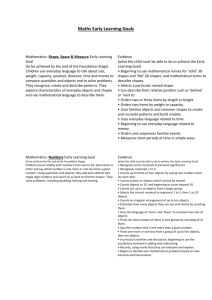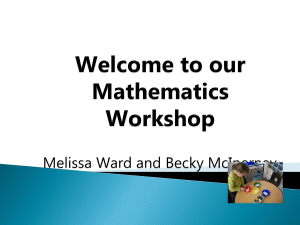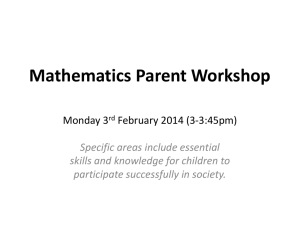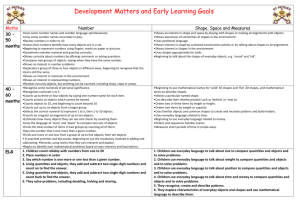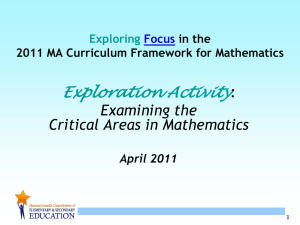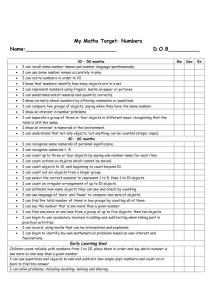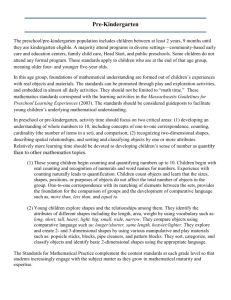Reception Medium Term Plan * Autumn
advertisement
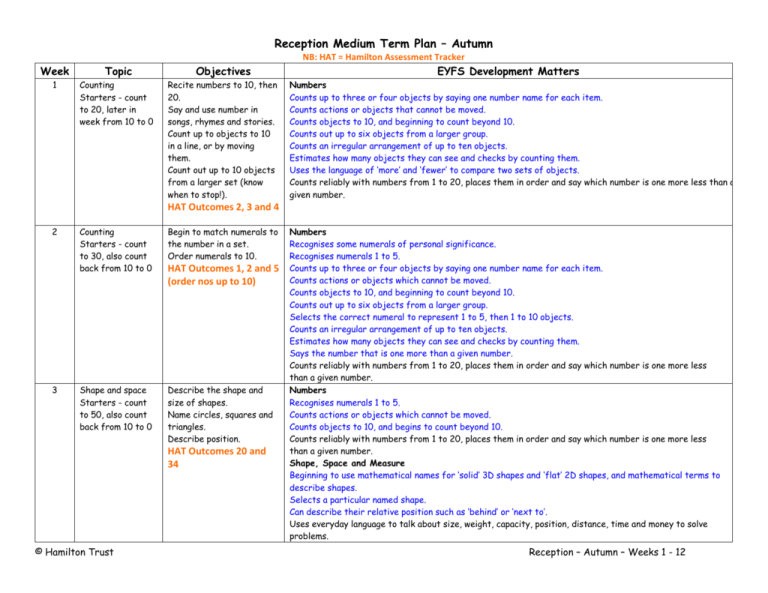
Reception Medium Term Plan – Autumn NB: HAT = Hamilton Assessment Tracker Week Topic Objectives 1 Counting Starters - count to 20, later in week from 10 to 0 Recite numbers to 10, then 20. Say and use number in songs, rhymes and stories. Count up to objects to 10 in a line, or by moving them. Count out up to 10 objects from a larger set (know when to stop!). EYFS Development Matters Numbers Counts up to three or four objects by saying one number name for each item. Counts actions or objects that cannot be moved. Counts objects to 10, and beginning to count beyond 10. Counts out up to six objects from a larger group. Counts an irregular arrangement of up to ten objects. Estimates how many objects they can see and checks by counting them. Uses the language of ‘more’ and ‘fewer’ to compare two sets of objects. Counts reliably with numbers from 1 to 20, places them in order and say which number is one more less than a given number. HAT Outcomes 2, 3 and 4 2 3 Counting Starters - count to 30, also count back from 10 to 0 Begin to match numerals to the number in a set. Order numerals to 10. Shape and space Starters - count to 50, also count back from 10 to 0 Describe the shape and size of shapes. Name circles, squares and triangles. Describe position. HAT Outcomes 1, 2 and 5 (order nos up to 10) HAT Outcomes 20 and 34 © Hamilton Trust Numbers Recognises some numerals of personal significance. Recognises numerals 1 to 5. Counts up to three or four objects by saying one number name for each item. Counts actions or objects which cannot be moved. Counts objects to 10, and beginning to count beyond 10. Counts out up to six objects from a larger group. Selects the correct numeral to represent 1 to 5, then 1 to 10 objects. Counts an irregular arrangement of up to ten objects. Estimates how many objects they can see and checks by counting them. Says the number that is one more than a given number. Counts reliably with numbers from 1 to 20, places them in order and say which number is one more less than a given number. Numbers Recognises numerals 1 to 5. Counts actions or objects which cannot be moved. Counts objects to 10, and begins to count beyond 10. Counts reliably with numbers from 1 to 20, places them in order and say which number is one more less than a given number. Shape, Space and Measure Beginning to use mathematical names for ‘solid’ 3D shapes and ‘flat’ 2D shapes, and mathematical terms to describe shapes. Selects a particular named shape. Can describe their relative position such as ‘behind’ or ‘next to’. Uses everyday language to talk about size, weight, capacity, position, distance, time and money to solve problems. Reception – Autumn – Weeks 1 - 12 Week 4 Topic Pattern Starters - count to 100, also back Objectives Continue a repeating pattern with two colours/shapes/objects. Rehearse counting to 20 as you do patterns. HAT Outcomes 22 and 32 5 Counting Adding (one more) Starters – keep rehearsing counting to 100/counting back Count on from any number to 10. Say the next number (i.e. say the number after a given number up to 10 without counting from 1). Read the corresponding addition. HAT Outcomes 2, 7 (up to 10) and 11 6 Addition (story of five) Starters - keep rehearsing counting to 100/counting back Find different ways to partition sets of five objects. Read the corresponding addition. Early subtraction – Guess how many are hiding. HAT Outcome 12 and 13 (addition) © Hamilton Trust EYFS Development Matters Explores characteristics of everyday objects and shapes and uses mathematical language to describe them. Numbers Recognises numerals 1 to 5. Counts actions or objects which cannot be moved. Counts objects to 10, and begins to count beyond 10. Counts reliably with numbers from 1 to 20, places them in order and say which number is one more less than a given number. Shape, Space and Measure Beginning to use mathematical names for ‘solid’ 3D shapes and ‘flat’ 2D shapes, and mathematical terms to describe shapes. Selects a particular named shape. Uses familiar objects and common shapes to create and recreate patterns and build models. Recognises, creates and describes patterns. Explores characteristics of everyday objects and shapes and uses mathematical language to describe them. Numbers Recognises numerals 1 to 5. Counts up to three or four objects by saying one number name for each item. Counts actions or objects which cannot be moved. Counts objects to 10, and beginning to count beyond 10. Selects the correct numeral to represent 1 to 5, then 1 to 10 objects. Says the number that is one more than a given number. Finds one more or one less from a group of up to five objects, then ten objects. In practical activities and discussion, is beginning to use the vocabulary involved in adding and subtracting. Counts reliably with numbers from one to 20, places them in order and says which number is one more or one less than a given number. Uses quantities and objects to add and subtract two single-digit numbers, and counts on or back to find the answer. Numbers Recognises numerals 1 to 5. Counts up to three or four objects by saying one number name for each item. Counts objects to 10, and beginning to count beyond 10. Selects the correct numeral to represent 1 to 5, then 1 to 10 objects. Finds the total number of items in two groups by counting all of them. Says the number that is one more than a given number. Finds one more or one less from a group of up to five objects, then ten objects. In practical activities and discussion, is beginning to use the vocabulary involved in adding and subtracting. Records, using marks that they can interpret and explain. Counts reliably with numbers from one to 20, places them in order and says which number is one more or one less than a given number. Uses quantities & objects to add & subtract two single-digit numbers, & counts on or back to find answer. Reception – Autumn – Weeks 1 - 12 Week Topic Objectives EYFS Development Matters Solve problems, including doubling, halving and sharing. 7 Counting Starters - keep rehearsing counting to 100/counting back Count up to 10 objects which can’t be moved. Match numerals to the number in a set. Understand zero to describe an empty set. Rehearse counting back from 10 to 0, including in songs, stories and rhymes. Count actions. HAT Outcomes 1, 2 , 5 (up to 10) and 17 (counting back) 8 Measures (length) Compare two lengths using direct comparison; use language of longer and shorter. Use uniform non-standard units to measure items up to 10 units long. Put three lengths in order. HAT Outcomes 24 and 25 9 Measures (height) Counting and comparing numbers © Hamilton Trust Compare two heights using direct comparison; use language of taller and shorter. Use uniform non-standard units to measure items up to 10 units high. Put three heights in order. Compare two numbers/quantities, use the language of ‘more’ and ‘less’. Numbers Recognises numerals 1 to 5. Counts up to three or four objects by saying one number name for each item. Counts actions or objects which cannot be moved. Counts objects to 10, and beginning to count beyond 10. Selects the correct numeral to represent 1 to 5, then 1 to 10 objects. Counts an irregular arrangement of up to ten objects. Says the number that is one more than a given number. Finds one more or one less from a group of up to five objects, then ten objects. In practical activities and discussion, begins to use the vocabulary involved in adding and subtracting. Counts reliably with numbers from one to 20, places them in order and says which number is one more or one less than a given number. Numbers Recognises numerals 1 to 5. Counts up to three or four objects by saying one number name for each item. Counts objects to 10, and beginning to count beyond 10. Selects the correct numeral to represent 1 to 5, then 1 to 10 objects. Says the number that is one more than a given number. Finds one more or one less from a group of up to five objects, then ten objects. Counts reliably with numbers from one to 20, places them in order and says which number is one more or one less than a given number. Shape, Space and Measure Orders two or three items by length or height. Uses everyday language to talk about size, weight, capacity, position, distance, time and money to solve problems. Explores characteristics of everyday objects and shapes and uses mathematical language to describe them. Numbers Recognises numerals 1 to 5. Counts objects to 10, and beginning to count beyond 10. Selects the correct numeral to represent 1 to 5, then 1 to 10 objects. Counts an irregular arrangement of up to ten objects/symbols Uses the language of ‘more’ and ‘fewer’ to compare two sets of objects. Says the number that is one more than a given number. Finds one more or one less from a group of up to five objects, then ten objects. In practical activities and discussion, is beginning to use the vocabulary involved in adding and subtracting. Counts reliably with numbers from one to 20, places them in order and says which number is one more or one less than a given number. Solves problems, including doubling, halving and sharing. Shape, Space and Measures Orders two or three items by length or height. Reception – Autumn – Weeks 1 - 12 Week 10 Topic Shape Objectives HAT Outcomes 9, 24, 25, 33 and 34 Begin to describe 3D shapes. Use 3D shapes to print and make models. HAT Outcomes 21, 22 and 33 11 Money ‘Real life’ problems Recognise £1 and £2 coins. Compare prices in pounds up to £10 (by making lines of pound coins). Use money in role play (e.g. pound shop). Solve practical problems involving counting or role play. HAT Outcomes 30 and 31 12 Time Use days of the week in context, e.g. story. Recognise a minute as unit of time. Count actions carried out in a minute (less than 20). HAT Outcomes 28, last part and 29 (week, day, minute) EYFS Development Matters Uses everyday language to talk about size, weight, capacity, position, distance, time and money to solve problems. Explores characteristics of everyday objects and shapes and uses mathematical language to describe them. Numbers Counts objects to 10, and beginning to count beyond 10. Says the number that is one more than a given number. Counts reliably with numbers from one to 20, places them in order and says which number is one more or one less than a given number. Shape, Space and Measures Beginning to use mathematical names for ‘solid’ 3D shapes and ‘flat’ 2D shapes, and mathematical terms to describe shapes. Selects a particular named shape. Uses familiar objects and common shapes to create and recreate patterns and build models. Explores characteristics of everyday objects and shapes and uses mathematical language to describe them. Numbers Counts objects to 10, and is beginning to count beyond 10. Uses the language of ‘more’ and ‘fewer’ to compare two sets of objects. Says the number that is one more than a given number. Counts reliably with numbers from one to 20, places them in order and says which number is one more or one less than a given number. Shape, Space and Measures Beginning to use everyday language related to money. Uses everyday language to talk about size, weight, capacity, position, distance, time and money to solve problems. Numbers Counts objects to 10, and is beginning to count beyond 10. Says the number that is one more than a given number. Counts reliably with numbers from one to 20, places them in order and says which number is one more or one less than a given number. Shape, Space and Measures Uses everyday language related to time. Orders and sequences familiar events. Measures short periods of time in simple ways. Uses everyday language to talk about size, weight, capacity, position, distance, time and money to solve problems. Key Black = Early Learning Goal Blue = Steps leading to the ELG © Hamilton Trust Reception – Autumn – Weeks 1 - 12 Reception – Outcomes 1. Recognise numerals 1-5 and some of personal significance; select the correct numeral to represent up to 10 objects. N 2. Count up to 5, then 10 objects, including in an irregular arrangement, match one-to-one; count actions, images, objects which cannot be moved. N 3. Count out a set of up to 6 objects from a larger group. N 4. Estimate how many objects they can see and check by counting them. N 5. ELG: Count reliably using numbers 1 to 20 and place the numbers in order. N 6. Compare two numbers up to 20, and find numbers in between. N 7. ELG: Say the number after a given number up to 20. N 8. ELG: Say the number before a given number up to 20. N 9. Use the language of ‘greater’ and ‘less than’ and ‘more’ and ‘fewer’ to compare two sets of objects. N 10. Find the total number of items in two groups by counting all of them; begin to find the total by counting on from the larger number. AS 11. Find one more than a group of up to 5 objects and then up to 10 objects. AS 12. In practical activities, perform additions and subtractions and use the appropriate and relevant vocabulary. AS 13. Use appropriate marks to record numbers and operations: begin to use +, – , and = to record additions and subtractions. AS 14. ELG: Say the number one more than a given number up to 20. AS 15. ELG: Say the number one less than a given number up to 20. AS 16. ELG: Add numbers (<10) of objects, images and quantities, counting on to find the answer, including counting on along a number track or line. 17. ELG: Subtract one single digit number from another in the context of a practical activity, including counting back along a number track or line. AS 18. Identify and begin to solve mathematical problems in the context of their own activity or interest. AS 19. ELG: Solve problems including doubling and halving or sharing. MD 20. Explore 2D shapes, begin to use mathematical names for these ‘flat’ shapes; select a named shape: circle, square, rectangle, triangle. G 21. Explore 3D shapes, begin to use mathematical names for ‘solid’ shapes; select a given named shape: sphere, cube, cuboid, pyramid, cone, cylinder. G 22. Use familiar objects and common shapes to create and recreate patterns and build models. G 23. Order/sequence everyday events, begin to understand that we can tell the time; recognise analogue/digital o’clock times; measure short times in simple ways. MS 24. ELG: Use everyday language to compare and order two or three items by length or height. MS 25. ELG: Begin to measure using repeated uniform units, e.g. crayons or footprints. MS 26. ELG: Use everyday language to compare and order 2/3 items by weight or capacity. MS 27. ELG: Begin to measure using repeated uniform units, e.g. conkers or egg-cups. MS 28. ELG: Use everyday language to sequence events and to compare durations (e.g. after two sleeps, all afternoon); understand that we can measure time. MS 29. Recognise the common units of time (minutes, hours, days, weeks, months, years). MS 30. ELG: Use everyday language to talk about money, to identify/describe coins; begin to understand that different coins have different values. MS 31. Exchange one coin for several of another and make small amounts. MS 32. ELG: Recognise, create and describe patterns. G 33. ELG: Explore characteristics of shapes and everyday objects and use mathematical language to describe them. G 34. ELG Use everyday language to describe position and direction, e.g. ‘behind’, ‘in front of’, ‘next to’, ‘underneath’, ‘on top of’. G © Hamilton Trust Reception – Autumn – Weeks 1 - 12 The letters in orange indicate the strand on Hamilton Assessment Tracker to which each Outcome belongs. © Hamilton Trust Reception – Autumn – Weeks 1 - 12
